college+of+engineering
-
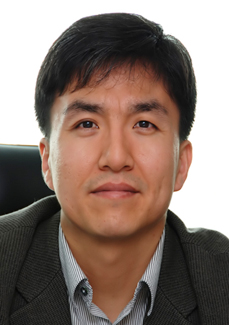 Prof. Cho Appointed Editor-in-Chief of Systems Biology Encyclopedia
Prof. Kwang-Hyun Cho of the Department of Bio and Brain Engineering, KAIST, has been appointed as the editor-in-chief of the Encyclopedia of Systems Biology which is currently in development by Springer, a New York-based publishing company, university authorities said on Monday (July 6).
Prof. Cho will share the position with three other eminent scholars from Britain, Germany and the United States. Cho will be responsible for selecting editorial members for each section of the Encyclopedia and overseeing the overall editorial process.
The Encyclopedia of Systems Biology is a multi-volume reference compilation of the research outcomes in the field of systems biology all over the world. The ESB will consist of alphabetically ordered description of systems biology concepts and is envisaged to ultimately comprise 6-12 volumes. Publication of the Encyclopedia is scheduled for 2011.
2009.07.08 View 14372
Prof. Cho Appointed Editor-in-Chief of Systems Biology Encyclopedia
Prof. Kwang-Hyun Cho of the Department of Bio and Brain Engineering, KAIST, has been appointed as the editor-in-chief of the Encyclopedia of Systems Biology which is currently in development by Springer, a New York-based publishing company, university authorities said on Monday (July 6).
Prof. Cho will share the position with three other eminent scholars from Britain, Germany and the United States. Cho will be responsible for selecting editorial members for each section of the Encyclopedia and overseeing the overall editorial process.
The Encyclopedia of Systems Biology is a multi-volume reference compilation of the research outcomes in the field of systems biology all over the world. The ESB will consist of alphabetically ordered description of systems biology concepts and is envisaged to ultimately comprise 6-12 volumes. Publication of the Encyclopedia is scheduled for 2011.
2009.07.08 View 14372 -
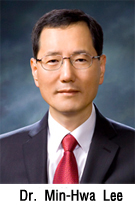 Lecture Hall Named After Venture Businessman Min-Hwa Lee
A lecture hall in the Alumni Start-Up Building on the KAIST campus was named Min-Hwa Lee Hall in a ceremony on Tuesday to pay tribute to KAIST alumnus Min-Hwa Lee"s contributions to the development of Korean venture business.
On hand at the ceremony were Sung-Woo Hong, head of the Small and Medium Business Administration, KAIST President Nam-Pyo Suh, dozens of KAIST alumni representatives, and figures from government research institutes.
Lee, who obtained his M.S. (1978) and Ph.D. (1985) in Electrical Engineering from KAIST, established a fund of 10 billion won along with other KAIST alumni in 2001 and donated it for the construction of the Alumni Start-Up Building for aspiring entrepreneurs. To remember his lofty vision, KAIST decided to name a lecture hall after him.
As a venture businessman, Lee founded the Madison, Ltd., one of the earliest venture companies in Korea, in 1985. Lee then played a leading role in the creation of the Korea Venture Industry Association in 1995, and in the establishment of KOSDAQ and the enactment of a special law for venture enterprises.
KAIST will appoint Lee as an adjunct professor in recognition of his expertise in venture business and commercialization of new inventions. Lee will teach entrepreneurship at the Graduate School of Management and the Institute for Gifted Students, a KAIST affiliate.
"Dr. Lee has made a great contribution to the development of Korean venture business. At a time when commercialization of new inventions was at an infant stage, he nurtured technology ventures and built the foundation for the proliferation of technology venture," President Suh said. "We expect that he will strive to open the generation of technologies which will lead the development of Korea in the future and become a mentor of aspiring entrepreneurs," Suh added.
2009.06.30 View 16701
Lecture Hall Named After Venture Businessman Min-Hwa Lee
A lecture hall in the Alumni Start-Up Building on the KAIST campus was named Min-Hwa Lee Hall in a ceremony on Tuesday to pay tribute to KAIST alumnus Min-Hwa Lee"s contributions to the development of Korean venture business.
On hand at the ceremony were Sung-Woo Hong, head of the Small and Medium Business Administration, KAIST President Nam-Pyo Suh, dozens of KAIST alumni representatives, and figures from government research institutes.
Lee, who obtained his M.S. (1978) and Ph.D. (1985) in Electrical Engineering from KAIST, established a fund of 10 billion won along with other KAIST alumni in 2001 and donated it for the construction of the Alumni Start-Up Building for aspiring entrepreneurs. To remember his lofty vision, KAIST decided to name a lecture hall after him.
As a venture businessman, Lee founded the Madison, Ltd., one of the earliest venture companies in Korea, in 1985. Lee then played a leading role in the creation of the Korea Venture Industry Association in 1995, and in the establishment of KOSDAQ and the enactment of a special law for venture enterprises.
KAIST will appoint Lee as an adjunct professor in recognition of his expertise in venture business and commercialization of new inventions. Lee will teach entrepreneurship at the Graduate School of Management and the Institute for Gifted Students, a KAIST affiliate.
"Dr. Lee has made a great contribution to the development of Korean venture business. At a time when commercialization of new inventions was at an infant stage, he nurtured technology ventures and built the foundation for the proliferation of technology venture," President Suh said. "We expect that he will strive to open the generation of technologies which will lead the development of Korea in the future and become a mentor of aspiring entrepreneurs," Suh added.
2009.06.30 View 16701 -
 KAIST to hold International Workshop on Flexible Displays
The 2009 KAIST International Workshop on Flexible Displays will take place at the Electrical Engineering Building on June 25, university sources said on Tuesday (June 23).
The workshop organized by the Center for Advanced Flexible Display Convergence (CAFDC) will explore the status and future vision of flexible and transparent plasma displays, which are among the key technologies for the development of the next-generation displays. There will be also discussions about technologies to realize the large-scale flexible and transparent display which is regarded as the display of the future.
Among the speakers are some of the most prominent figures in the field. Gary Eden from University of Illinois, Prof. Kunihide Tachibana from Kyoto University, and Carol Wedding, the president of Imaging Systems Tech., USA and several other well-known professors and engineers will participate in the workshop.
Professor Kyung-Cheol Choi, CAFDC chair, said: "The workshop will provide an excellent opportunity to examine the flexible and transparent plasma display technologies. It will also be a good chance to explore large-scale flexible and transparent displays from various technical viewpoints."
2009.06.24 View 19787
KAIST to hold International Workshop on Flexible Displays
The 2009 KAIST International Workshop on Flexible Displays will take place at the Electrical Engineering Building on June 25, university sources said on Tuesday (June 23).
The workshop organized by the Center for Advanced Flexible Display Convergence (CAFDC) will explore the status and future vision of flexible and transparent plasma displays, which are among the key technologies for the development of the next-generation displays. There will be also discussions about technologies to realize the large-scale flexible and transparent display which is regarded as the display of the future.
Among the speakers are some of the most prominent figures in the field. Gary Eden from University of Illinois, Prof. Kunihide Tachibana from Kyoto University, and Carol Wedding, the president of Imaging Systems Tech., USA and several other well-known professors and engineers will participate in the workshop.
Professor Kyung-Cheol Choi, CAFDC chair, said: "The workshop will provide an excellent opportunity to examine the flexible and transparent plasma display technologies. It will also be a good chance to explore large-scale flexible and transparent displays from various technical viewpoints."
2009.06.24 View 19787 -
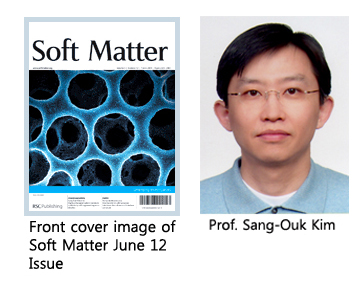 Prof. Sang-Ouk Kim Featured on the Cover of Emerging Investigator Special Issue
KAIST Prof. Sang-Ouk Kim of the Department of Materials Science and Engineering was featured on the cover of the Emerging Investigator Special Issue published by Britain"s Royal Society of Chemistry on June 21, university authorities said on Monday (June 22).
The special issue shed spotlight on 18 up-and-coming scientists who have been selected through the recommendation and rigorous screening process of the editorial and advisory boards of the Royal Society of Chemistry. The 18 scientists consist of six from the American continent, 10 from Europe, one from Japan and one from Korea.
The journal introduced Prof. Kim"s paper, titled "Highly entangled carbon nanotube (CNT) scaffolds by self-organized aqueous droplets." Kim explained in the paper that the cellular CNT demonstrated high electrical conductivity and field-emission properties, which is potentially useful for various applications in electronics and energy storage devices.
2009.06.24 View 14192
Prof. Sang-Ouk Kim Featured on the Cover of Emerging Investigator Special Issue
KAIST Prof. Sang-Ouk Kim of the Department of Materials Science and Engineering was featured on the cover of the Emerging Investigator Special Issue published by Britain"s Royal Society of Chemistry on June 21, university authorities said on Monday (June 22).
The special issue shed spotlight on 18 up-and-coming scientists who have been selected through the recommendation and rigorous screening process of the editorial and advisory boards of the Royal Society of Chemistry. The 18 scientists consist of six from the American continent, 10 from Europe, one from Japan and one from Korea.
The journal introduced Prof. Kim"s paper, titled "Highly entangled carbon nanotube (CNT) scaffolds by self-organized aqueous droplets." Kim explained in the paper that the cellular CNT demonstrated high electrical conductivity and field-emission properties, which is potentially useful for various applications in electronics and energy storage devices.
2009.06.24 View 14192 -
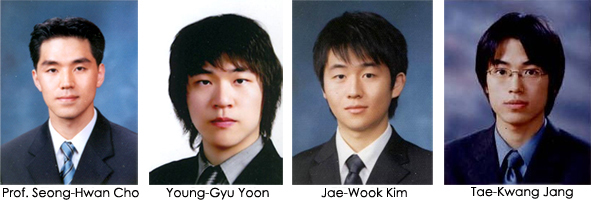 Prof. Cho's Team Awarded Best Paper Prize by IEEE
A team led by Prof. Seong-Hwan Cho of the School of Electrical Engineering and Computer Science, KAIST, won the 2009 Guillemin-Cauer Best Paper Award for their paper published in the IEEE Transactions on Circuits and Systems Journal last May, university authorities said on Thursday (June 4).
The team"s paper was entitled "A Time-based Bandpass ADC Using Time-Interleaved Voltage-Controlled Oscillators." The prize is given to a paper regarded as the best among about 350 papers published in the prestigious journal in the circuit theory area. Co-recipients of the award are Young-Gyu Yoon, Jae-Wook Kim and Tae-Kwang Jang. The award was presented at the annual 2009 International Symposium for Circuits and Systems in Taipei, Taiwan, on May 26.
The Institute of Electrical and Electronics Engineers or IEEE is an international non-profit, professional organization for the advancement of technology related to electricity. The New York-based organization has more than 365,000 members in about 150 countries making it the largest technical professional organization in the world.
2009.06.05 View 14970
Prof. Cho's Team Awarded Best Paper Prize by IEEE
A team led by Prof. Seong-Hwan Cho of the School of Electrical Engineering and Computer Science, KAIST, won the 2009 Guillemin-Cauer Best Paper Award for their paper published in the IEEE Transactions on Circuits and Systems Journal last May, university authorities said on Thursday (June 4).
The team"s paper was entitled "A Time-based Bandpass ADC Using Time-Interleaved Voltage-Controlled Oscillators." The prize is given to a paper regarded as the best among about 350 papers published in the prestigious journal in the circuit theory area. Co-recipients of the award are Young-Gyu Yoon, Jae-Wook Kim and Tae-Kwang Jang. The award was presented at the annual 2009 International Symposium for Circuits and Systems in Taipei, Taiwan, on May 26.
The Institute of Electrical and Electronics Engineers or IEEE is an international non-profit, professional organization for the advancement of technology related to electricity. The New York-based organization has more than 365,000 members in about 150 countries making it the largest technical professional organization in the world.
2009.06.05 View 14970 -
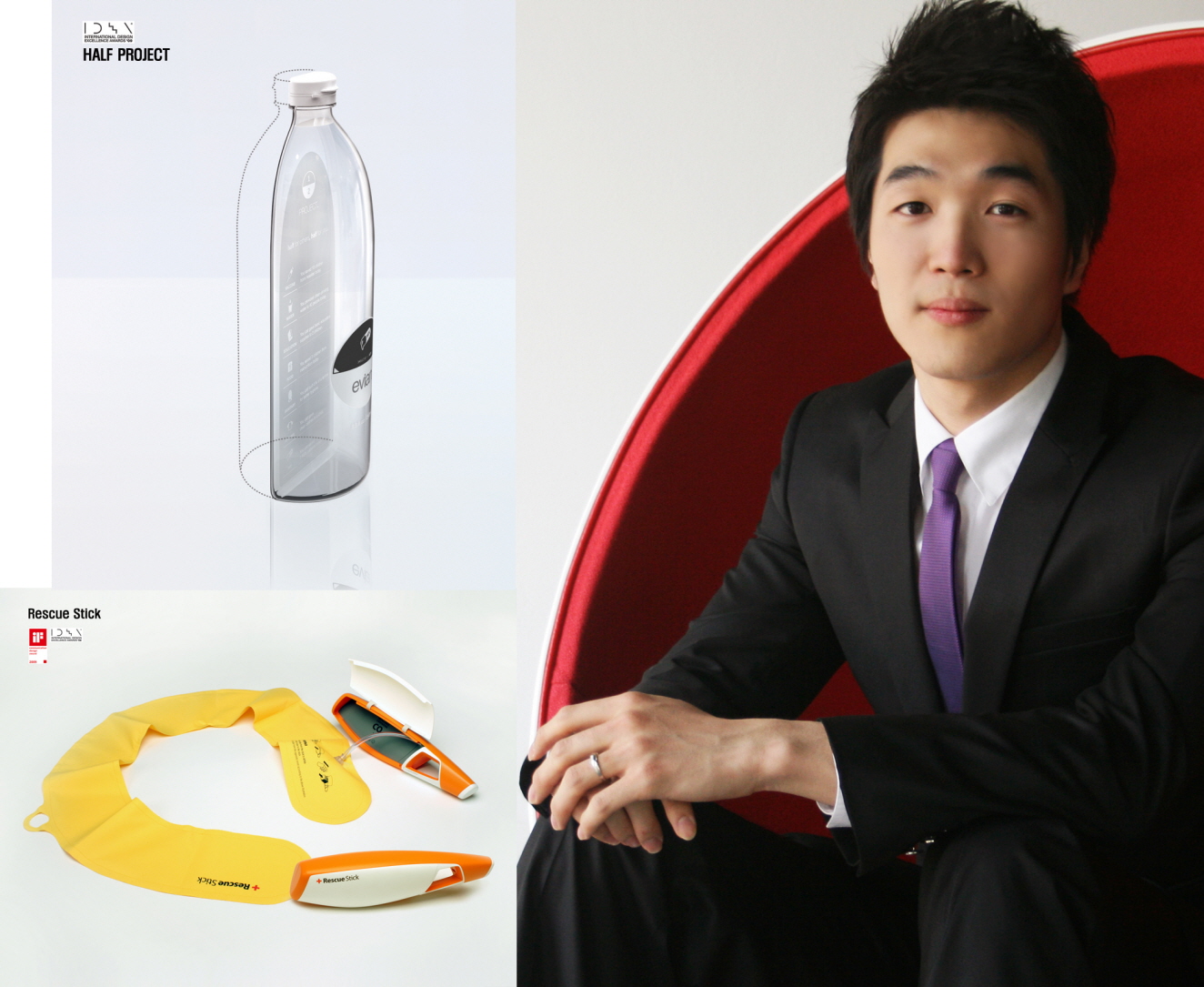 KAIST Senior Wins Prizes at International Design Contests
Sung-Joon Kim, a senior at the Department of Industrial Design, KAIST, has recently won the highest prize at the iF Communication Design Award held in Hanover, Germany, university officials said on Monday (June 3).
The prizewinning work entitled "1/2 PROJECT" introduces a donation system in which a customer buys a bottle of drink, for example, containing only a half of its price value and donate the remaining half of the value. The work which was created as part of the Samsung Design Membership was also awarded a silver prize at the International Design Excellence Awards (IDEA) of the United States.
Award ceremonies of the two prizes are scheduled for in Muenchen in August and in Miami in September, respectively.
"The design project is aimed at making donation a part of everyday life by teaming up with big-name beverage makers," said Kim.
iF Communication Design Award and the IDEA are among the world"s three leading international design competitions. The other one is the Red Dot Design Award presented in Essen, Germany.
Early this year, Kim, leading a team, presented a portable life saving equipment called "Rescue Stick" to the two competitions and won high honors.
2009.06.05 View 15466
KAIST Senior Wins Prizes at International Design Contests
Sung-Joon Kim, a senior at the Department of Industrial Design, KAIST, has recently won the highest prize at the iF Communication Design Award held in Hanover, Germany, university officials said on Monday (June 3).
The prizewinning work entitled "1/2 PROJECT" introduces a donation system in which a customer buys a bottle of drink, for example, containing only a half of its price value and donate the remaining half of the value. The work which was created as part of the Samsung Design Membership was also awarded a silver prize at the International Design Excellence Awards (IDEA) of the United States.
Award ceremonies of the two prizes are scheduled for in Muenchen in August and in Miami in September, respectively.
"The design project is aimed at making donation a part of everyday life by teaming up with big-name beverage makers," said Kim.
iF Communication Design Award and the IDEA are among the world"s three leading international design competitions. The other one is the Red Dot Design Award presented in Essen, Germany.
Early this year, Kim, leading a team, presented a portable life saving equipment called "Rescue Stick" to the two competitions and won high honors.
2009.06.05 View 15466 -
 Prof. Chung Appointed Chief Design Officer of Seoul City
Prof. Kyung-Won Chung of the Department of Industrial Design, KAIST, has been appointed as the new chief design officer of the Seoul Metropolitan City, university sources said on Tuesday (May 26).
Chung succeeded Prof, Young-Gull Kwon of Seoul National University who served as the inaugural head of the design division since 2007. The deputy-mayor level position has a two-year term.
With a vision to turn Seoul into a "global design hub," the Seoul city administration established the design division and initiated a slew of initiatives including design competitions aimed at improving the city"s looks.
Prof. Chung graduated from Seoul National University and its graduate school. Then, he earned a master"s degree from Syracuse University, New York, and a doctorate from Manchester Metropolitan University in Britain. Since February 2009, he has served as an executive of the newly-created Seoul Design Foundation. He also served as president of the Korea Institute of Design Promotion (KIDP) from February 2000 through May 2003.
2009.05.28 View 10542
Prof. Chung Appointed Chief Design Officer of Seoul City
Prof. Kyung-Won Chung of the Department of Industrial Design, KAIST, has been appointed as the new chief design officer of the Seoul Metropolitan City, university sources said on Tuesday (May 26).
Chung succeeded Prof, Young-Gull Kwon of Seoul National University who served as the inaugural head of the design division since 2007. The deputy-mayor level position has a two-year term.
With a vision to turn Seoul into a "global design hub," the Seoul city administration established the design division and initiated a slew of initiatives including design competitions aimed at improving the city"s looks.
Prof. Chung graduated from Seoul National University and its graduate school. Then, he earned a master"s degree from Syracuse University, New York, and a doctorate from Manchester Metropolitan University in Britain. Since February 2009, he has served as an executive of the newly-created Seoul Design Foundation. He also served as president of the Korea Institute of Design Promotion (KIDP) from February 2000 through May 2003.
2009.05.28 View 10542 -
 International News Outlets Report on KAIST's On-Line Electric Vehicle Project
International news agencies such as the Associated Press and Reuters have recently reported on the "online" electric vehicle project KAIST is proceeding with. A number of newspapers abroad including the New York Times and the South China Morning Post of Hong Kong published the articles. Following are excerpts from those reports.
-------------------
S. Koreans designing "online" electric vehicles
By JEAN H. LEE
Associated Press
Urban visionaries in London and Seoul, two of the world"s busiest capital cities, foresee buses gliding through their streets with speed, ease and efficiency _ without emitting the exhaust fumes that scientists say are contributing to global warming.Under Mayor Boris Johnson"s vision, London"s iconic red double-decker Routemaster buses would be back on the streets _ but powered by electricity, not gasoline.
Engineers at South Korea"s top-ranked KAIST university are meanwhile working on a novel prototype for an electric vehicle system: one that provides power on the go through induction strips laid into the roadway.
Cities _ which house 75 percent of the world"s population and generate 80 percent of its pollution _ must take leadership in tackling the problem of polluting emissions, Johnson said Monday in Seoul on the eve of the third C40 Large Cities Climate Summit.
"I think as a collective of cities, what we should be doing here in Seoul is agreeing that we are going to stop the endless addiction of mankind to the internal combustion engine," he told reporters. "It"s time that we moved away from fossil fuels. It"s time that we went for low-carbon vehicles."
"Cars form many problems that we see in Korea as well as other countries. We use hydrocarbon organic fuels, mostly petroleum, and that, in turn, creates environmental problems _ and Seoul is notorious," said Suh Nam-pyo, president of KAIST in Daejeon, south of the South Korean capital.
Seoul, population 10 million, is getting warmer three times faster than the world average, the National Meteorological Administration said Monday.
The obvious solution, Suh said, is to "replace all these vehicles with vehicles that do not pollute the air and do not use oil."
Back in March, Johnson zipped down a British highway in a U.S.-made electric car that he wrote marked "the beginning of a long-overdue revolution."
He rhapsodized in a Telegraph newspaper editorial that the Tesla has no exhaust pipe, carburetor or fuel tank, and "while every other car on that motorway was a-parping and a-puttering, filling the air with fumes and particulates, this car was producing no more noxious vapours than a dandelion in an alpine meadow."
Last month, he launched an ambitious plan to get 100,000 electric cars onto the streets of London by 2015. He pushed for the creation of 25,000 charging stations and vowed to convert some 1,000 city vehicles to make London the "electric car capital of Europe."
"The age of the diesel-emitting bus has got to be over in London," Johnson said.
And scientists are still grappling with the massive, sensitive, costly and fast-depleting batteries that take the place of international combustion engines and gasoline. Electric cars run between 40 and 120 miles (60 to 200 kilometers) on one charge, and it takes anywhere from two to seven hours to fully recharge, said Christian Mueller of the IHS Global Insight consulting firm.
"Everybody is frantically working on coming up with a viable electric car," he said from Frankfurt, Germany.
Batteries "aren"t yet at a state where we can say they are cheap, they"re reliable and they"re easy to come by. They all still have their technical drawbacks," said Mueller, who specializes in electrics and electronics.
Suh, an MIT-trained inventor with some 60 international patents to his name, approached the challenge from another angle.
"Why not have power transmitted on the ground and pick it up without using mechanical contact?" he said in an interview in his office overlooking the staging grounds for the university"s electric cars.
KAIST"s "online" vehicles pick up power from trips, or inverters, embedded into the road rather than transmitted through rails or overhead wires. A small battery, one-fifth the size of the bulky batteries typically used, would give the vehicle enough power for another 50 miles (80 kilometers), said Cho Dong-ho, the scientist in charge of the project.
South Korea produces its own nuclear power, meaning it can produce a continuous supply of energy to fuel such a plan.
President Lee Myung-bak, whose government gave KAIST $50 million for two major projects, including the "online" electric vehicle, took a spin in February.
Online buses are running at the KAIST campus and will begin test runs soon on the resort island of Jeju.
But Seoul, which has promised to set aside $2 million for the underground charging system, is within Suh"s sights. He said 9,000 gasoline-fueled buses now crisscross the capital, with 1,000 going out of commission each year. He envisions replacing those aging buses with electric models. Initial test runs are expected to take place this year.
Mueller, the consultant, called it a creative approach with potential.
"It sounds very intriguing; you don"t store your energy, you provide it on the go." he said. "The (battery) storage problem is overcome instantly. That would be a very intriguing way of doing it."
-----------------------------
South Korea tries recharging road to power vehicles
By Jon Herskovitz
SEOUL (Reuters) - South Korea"s top technology university has developed a plan to power electric cars through recharging strips embedded in roadways that use a technology to transfer energy found in some electric toothbrushes.
The plan, still in the experimental stage, calls for placing power strips about 20 cm (8 inches) to 90 cm (35 inches) wide and perhaps several hundred meters long built into the top of roads.
Vehicles with sensor-driven magnetic devices on their underside can suck up energy as they travel over the strips without coming into direct contact.
"If we place these strips on about 10 percent of roadways in a city, we could power electric vehicles," said Cho Dong-ho, the manager of the "online electric vehicle" plan at the Korea Advanced Institute of Science and Technology.
The university has built a prototype at its campus in Daejeon, about 140 km (90 miles) south of Seoul, for electric-powered golf carts and is working on designs that would power cars and buses.
The system that can charge several vehicles at once would allow electric cars and buses to cut down on their battery sizes or extend their ranges.
The non-contact transfer of electricity, also called inductive charging, works by magnets and cables on the underside of the vehicle making a connection with the current in the recharging strip to receive power as they travel over it.
It is employed in some brands of electric toothbrushes that are sealed and water resistant, which do not need to be plugged into anything but use a magnetic connection to receive energy while resting in a cradle.
The recharging strips, which are attached to small electrical stations, would be laid in places such as bus lanes and the roads running up to intersections so that vehicles could power up where traffic slows down, Cho said.
The system will be tested later this year for use in the bus systems of Seoul and other South Korea cities while some of the country"s automakers are also cooperating in the project.
Unlike electric lines used for trams, vehicles do not need to be in constant contact with the strips and a person can touch the lines without receiving a shock.
The system so far has proven safe to humans and machinery, Cho said.
The cost of installing the system is an estimated 400 million won ($318,000) per kilometer of road. Electricity is extra.
2009.05.21 View 16833
International News Outlets Report on KAIST's On-Line Electric Vehicle Project
International news agencies such as the Associated Press and Reuters have recently reported on the "online" electric vehicle project KAIST is proceeding with. A number of newspapers abroad including the New York Times and the South China Morning Post of Hong Kong published the articles. Following are excerpts from those reports.
-------------------
S. Koreans designing "online" electric vehicles
By JEAN H. LEE
Associated Press
Urban visionaries in London and Seoul, two of the world"s busiest capital cities, foresee buses gliding through their streets with speed, ease and efficiency _ without emitting the exhaust fumes that scientists say are contributing to global warming.Under Mayor Boris Johnson"s vision, London"s iconic red double-decker Routemaster buses would be back on the streets _ but powered by electricity, not gasoline.
Engineers at South Korea"s top-ranked KAIST university are meanwhile working on a novel prototype for an electric vehicle system: one that provides power on the go through induction strips laid into the roadway.
Cities _ which house 75 percent of the world"s population and generate 80 percent of its pollution _ must take leadership in tackling the problem of polluting emissions, Johnson said Monday in Seoul on the eve of the third C40 Large Cities Climate Summit.
"I think as a collective of cities, what we should be doing here in Seoul is agreeing that we are going to stop the endless addiction of mankind to the internal combustion engine," he told reporters. "It"s time that we moved away from fossil fuels. It"s time that we went for low-carbon vehicles."
"Cars form many problems that we see in Korea as well as other countries. We use hydrocarbon organic fuels, mostly petroleum, and that, in turn, creates environmental problems _ and Seoul is notorious," said Suh Nam-pyo, president of KAIST in Daejeon, south of the South Korean capital.
Seoul, population 10 million, is getting warmer three times faster than the world average, the National Meteorological Administration said Monday.
The obvious solution, Suh said, is to "replace all these vehicles with vehicles that do not pollute the air and do not use oil."
Back in March, Johnson zipped down a British highway in a U.S.-made electric car that he wrote marked "the beginning of a long-overdue revolution."
He rhapsodized in a Telegraph newspaper editorial that the Tesla has no exhaust pipe, carburetor or fuel tank, and "while every other car on that motorway was a-parping and a-puttering, filling the air with fumes and particulates, this car was producing no more noxious vapours than a dandelion in an alpine meadow."
Last month, he launched an ambitious plan to get 100,000 electric cars onto the streets of London by 2015. He pushed for the creation of 25,000 charging stations and vowed to convert some 1,000 city vehicles to make London the "electric car capital of Europe."
"The age of the diesel-emitting bus has got to be over in London," Johnson said.
And scientists are still grappling with the massive, sensitive, costly and fast-depleting batteries that take the place of international combustion engines and gasoline. Electric cars run between 40 and 120 miles (60 to 200 kilometers) on one charge, and it takes anywhere from two to seven hours to fully recharge, said Christian Mueller of the IHS Global Insight consulting firm.
"Everybody is frantically working on coming up with a viable electric car," he said from Frankfurt, Germany.
Batteries "aren"t yet at a state where we can say they are cheap, they"re reliable and they"re easy to come by. They all still have their technical drawbacks," said Mueller, who specializes in electrics and electronics.
Suh, an MIT-trained inventor with some 60 international patents to his name, approached the challenge from another angle.
"Why not have power transmitted on the ground and pick it up without using mechanical contact?" he said in an interview in his office overlooking the staging grounds for the university"s electric cars.
KAIST"s "online" vehicles pick up power from trips, or inverters, embedded into the road rather than transmitted through rails or overhead wires. A small battery, one-fifth the size of the bulky batteries typically used, would give the vehicle enough power for another 50 miles (80 kilometers), said Cho Dong-ho, the scientist in charge of the project.
South Korea produces its own nuclear power, meaning it can produce a continuous supply of energy to fuel such a plan.
President Lee Myung-bak, whose government gave KAIST $50 million for two major projects, including the "online" electric vehicle, took a spin in February.
Online buses are running at the KAIST campus and will begin test runs soon on the resort island of Jeju.
But Seoul, which has promised to set aside $2 million for the underground charging system, is within Suh"s sights. He said 9,000 gasoline-fueled buses now crisscross the capital, with 1,000 going out of commission each year. He envisions replacing those aging buses with electric models. Initial test runs are expected to take place this year.
Mueller, the consultant, called it a creative approach with potential.
"It sounds very intriguing; you don"t store your energy, you provide it on the go." he said. "The (battery) storage problem is overcome instantly. That would be a very intriguing way of doing it."
-----------------------------
South Korea tries recharging road to power vehicles
By Jon Herskovitz
SEOUL (Reuters) - South Korea"s top technology university has developed a plan to power electric cars through recharging strips embedded in roadways that use a technology to transfer energy found in some electric toothbrushes.
The plan, still in the experimental stage, calls for placing power strips about 20 cm (8 inches) to 90 cm (35 inches) wide and perhaps several hundred meters long built into the top of roads.
Vehicles with sensor-driven magnetic devices on their underside can suck up energy as they travel over the strips without coming into direct contact.
"If we place these strips on about 10 percent of roadways in a city, we could power electric vehicles," said Cho Dong-ho, the manager of the "online electric vehicle" plan at the Korea Advanced Institute of Science and Technology.
The university has built a prototype at its campus in Daejeon, about 140 km (90 miles) south of Seoul, for electric-powered golf carts and is working on designs that would power cars and buses.
The system that can charge several vehicles at once would allow electric cars and buses to cut down on their battery sizes or extend their ranges.
The non-contact transfer of electricity, also called inductive charging, works by magnets and cables on the underside of the vehicle making a connection with the current in the recharging strip to receive power as they travel over it.
It is employed in some brands of electric toothbrushes that are sealed and water resistant, which do not need to be plugged into anything but use a magnetic connection to receive energy while resting in a cradle.
The recharging strips, which are attached to small electrical stations, would be laid in places such as bus lanes and the roads running up to intersections so that vehicles could power up where traffic slows down, Cho said.
The system will be tested later this year for use in the bus systems of Seoul and other South Korea cities while some of the country"s automakers are also cooperating in the project.
Unlike electric lines used for trams, vehicles do not need to be in constant contact with the strips and a person can touch the lines without receiving a shock.
The system so far has proven safe to humans and machinery, Cho said.
The cost of installing the system is an estimated 400 million won ($318,000) per kilometer of road. Electricity is extra.
2009.05.21 View 16833 -
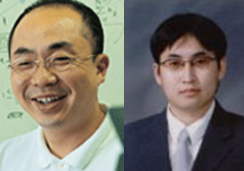 Prof. Chong Unveils New Human Movement Model
A KAIST research team headed by Prof. Song Chong of the School of Electrical Engineering and Computer Science has developed a new statistical model that simulates human mobility patterns, mimicking the way people move over the course of a day, a month or longer, university sources said on Tuesday (May 12).
The model, developed in collaboration with scientists at North Carolina State University, is the first to represent the regular movement patterns of humans using statistical data.
The model has a variety of potential uses, ranging from land use planning to public health studies on epidemic disease.
The researchers gave global positioning system (GPS) devices to approximately 100 volunteers at five locations in the U.S. and South Korea and tracked the participants" movements over time. By tracing the points where the study participants stopped, and their movement trajectories, researchers were able to determine patterns of mobility behavior.
The researchers were then able to emulate these fundamental statistical properties of human mobility into a model that could be used to represent the regular daily movement of humans. The model, called Self-similar Least Action Walk (SLAW), will have a wide array of practical applications.
The research, "SLAW: A Mobility Model for Human Walks," was presented on April 20 at the 28th IEEE Conference on Computer Communications in Rio de Janeiro, Brazil. The National Science Foundation of the U.S. funded the research.
2009.05.13 View 14969
Prof. Chong Unveils New Human Movement Model
A KAIST research team headed by Prof. Song Chong of the School of Electrical Engineering and Computer Science has developed a new statistical model that simulates human mobility patterns, mimicking the way people move over the course of a day, a month or longer, university sources said on Tuesday (May 12).
The model, developed in collaboration with scientists at North Carolina State University, is the first to represent the regular movement patterns of humans using statistical data.
The model has a variety of potential uses, ranging from land use planning to public health studies on epidemic disease.
The researchers gave global positioning system (GPS) devices to approximately 100 volunteers at five locations in the U.S. and South Korea and tracked the participants" movements over time. By tracing the points where the study participants stopped, and their movement trajectories, researchers were able to determine patterns of mobility behavior.
The researchers were then able to emulate these fundamental statistical properties of human mobility into a model that could be used to represent the regular daily movement of humans. The model, called Self-similar Least Action Walk (SLAW), will have a wide array of practical applications.
The research, "SLAW: A Mobility Model for Human Walks," was presented on April 20 at the 28th IEEE Conference on Computer Communications in Rio de Janeiro, Brazil. The National Science Foundation of the U.S. funded the research.
2009.05.13 View 14969 -
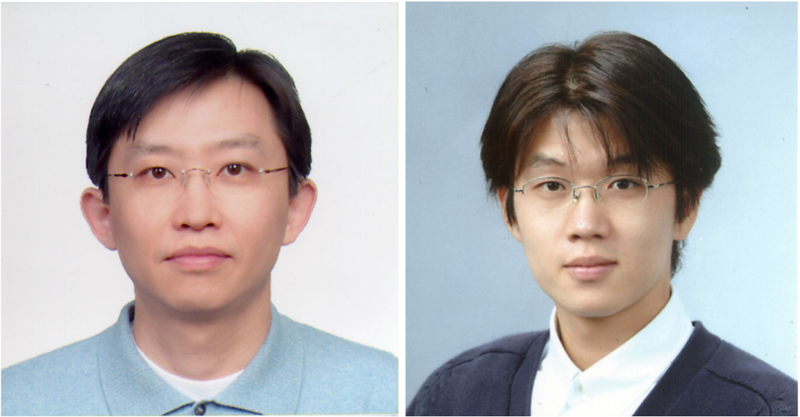 KAIST Professor Unveils New Method of Manufacturing Complex Nano-wire
A KAIST research team led by Prof. Sang-Ouk Kim of the Department of Materials Science and Engineering has discovered a new nanowire manufacturing method, university sources said on Monday (May 11).
The KAIST researchers successfully demonstrated soft graphoepitaxy of block copolymer assembly as a facile, scalable nanolithography for highly ordered sub-30-nm scale features. Graphoepitaxy is a new technique that uses artificial surface relief structure to induce crystallographic orientation in thin films.
Various morphologies of hierarchical block copolymer assembly were achieved by means of disposable topographic confinement of photoresist pattern. Unlike usual graphoepitaxy, soft graphoepitaxy generates the functional nanostrutures of metal and semiconductor nanowire arrays without any trace of structure-directing topographic pattern.
The discovery was featured in the May 7 edition of Nano-Letters. Application has been made for the domestic patent of the new method.
The new method is expected to be advantageous for multi-layer overlay processing required for complex device architecture, the sources said.
2009.05.12 View 11629
KAIST Professor Unveils New Method of Manufacturing Complex Nano-wire
A KAIST research team led by Prof. Sang-Ouk Kim of the Department of Materials Science and Engineering has discovered a new nanowire manufacturing method, university sources said on Monday (May 11).
The KAIST researchers successfully demonstrated soft graphoepitaxy of block copolymer assembly as a facile, scalable nanolithography for highly ordered sub-30-nm scale features. Graphoepitaxy is a new technique that uses artificial surface relief structure to induce crystallographic orientation in thin films.
Various morphologies of hierarchical block copolymer assembly were achieved by means of disposable topographic confinement of photoresist pattern. Unlike usual graphoepitaxy, soft graphoepitaxy generates the functional nanostrutures of metal and semiconductor nanowire arrays without any trace of structure-directing topographic pattern.
The discovery was featured in the May 7 edition of Nano-Letters. Application has been made for the domestic patent of the new method.
The new method is expected to be advantageous for multi-layer overlay processing required for complex device architecture, the sources said.
2009.05.12 View 11629 -
 Industrial Design Senior Wins Top Award at International Forum Design
Sung-Joon Kim, a senior at the Department of Industrial Design, KAIST, has won the highest award at the International Forum Design held in Hanover, Germany, university sources said on Monday (April 13).
At the design exhibition held in February under the theme of "life, live, work," Kim presented "Rescue Stick," a portable life saving equipment and "Recovery Arm Sling," a medical treatment device, in cooperation with three students from other Korean universities. Both entries were included among the 15 works selected as the top designs.
The design competition has been organized by iF International Forum Design, known as one of the world"s three leading design exhibitions.
Kim, leader of the team, received the prize at the awarding ceremony held in Nuremberg on March 24. The award-winning designs were on display at the design fair of the Altenpflege + Propflege, a nursing care exhibition, in the same city on March 24-26.
2009.04.15 View 13099
Industrial Design Senior Wins Top Award at International Forum Design
Sung-Joon Kim, a senior at the Department of Industrial Design, KAIST, has won the highest award at the International Forum Design held in Hanover, Germany, university sources said on Monday (April 13).
At the design exhibition held in February under the theme of "life, live, work," Kim presented "Rescue Stick," a portable life saving equipment and "Recovery Arm Sling," a medical treatment device, in cooperation with three students from other Korean universities. Both entries were included among the 15 works selected as the top designs.
The design competition has been organized by iF International Forum Design, known as one of the world"s three leading design exhibitions.
Kim, leader of the team, received the prize at the awarding ceremony held in Nuremberg on March 24. The award-winning designs were on display at the design fair of the Altenpflege + Propflege, a nursing care exhibition, in the same city on March 24-26.
2009.04.15 View 13099 -
 KAIST Research Team Discovers Process for Rapid Growth of N-Doped CNT Arrays
A team of scientists led by Profs. Sang-Ouk Kim, Won-Jong Lee and Duck-Hyun Lee of the Department of Materials Science and Engineering has found a straightforward process for rapid growth of wall-number selected, nitrogen-doped carbon nanotube (CNT) arrays, university officials said on Monday (March 16).
KAIST researchers prepared highly uniform nanopatterned iron catalyst arrays by tilted deposition through block copolymer nanotemplates. This remarkably fast growth of highly uniform N-doped CNTs, whose material properties and chemical functionalizability are reinforced by N-doping, offers a new area of a large-scale nanofabrication, potentially useful for diverse nano-devices.
Carbon nanotubes (CNTs) are of broad technical interest in electronics, photonics, energy devices, and other applications. However, establishing a straightforward process for mass production of uniform CNTs with desired structure and properties has been a long-standing challenge.
In particular, it was strongly desired to precisely control the numbers of walls and diameter of CNTs, which are decisive parameters for the physical properties of CNTs. In this respect, the preparation of monodisperse catalyst array having a narrow size distribution is generally considered an effective pathway to produce well-defined CNTs, since the number of walls and diameter of the produced CNTs are closely related to the catalyst size.
The finding was featured in the March 13 edition of Nano Letters, a leading journal in the nano technology field.
2009.03.20 View 15067
KAIST Research Team Discovers Process for Rapid Growth of N-Doped CNT Arrays
A team of scientists led by Profs. Sang-Ouk Kim, Won-Jong Lee and Duck-Hyun Lee of the Department of Materials Science and Engineering has found a straightforward process for rapid growth of wall-number selected, nitrogen-doped carbon nanotube (CNT) arrays, university officials said on Monday (March 16).
KAIST researchers prepared highly uniform nanopatterned iron catalyst arrays by tilted deposition through block copolymer nanotemplates. This remarkably fast growth of highly uniform N-doped CNTs, whose material properties and chemical functionalizability are reinforced by N-doping, offers a new area of a large-scale nanofabrication, potentially useful for diverse nano-devices.
Carbon nanotubes (CNTs) are of broad technical interest in electronics, photonics, energy devices, and other applications. However, establishing a straightforward process for mass production of uniform CNTs with desired structure and properties has been a long-standing challenge.
In particular, it was strongly desired to precisely control the numbers of walls and diameter of CNTs, which are decisive parameters for the physical properties of CNTs. In this respect, the preparation of monodisperse catalyst array having a narrow size distribution is generally considered an effective pathway to produce well-defined CNTs, since the number of walls and diameter of the produced CNTs are closely related to the catalyst size.
The finding was featured in the March 13 edition of Nano Letters, a leading journal in the nano technology field.
2009.03.20 View 15067